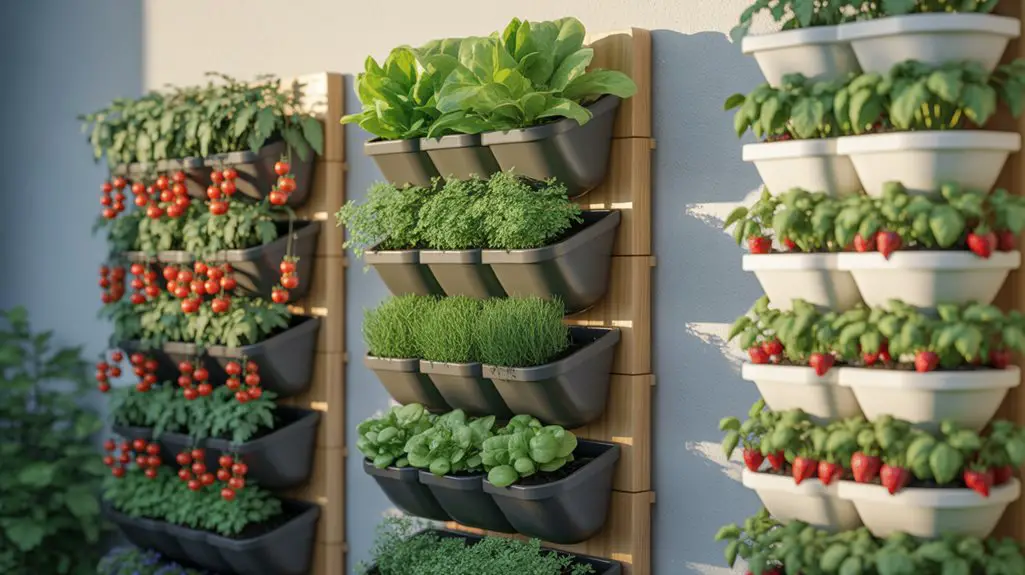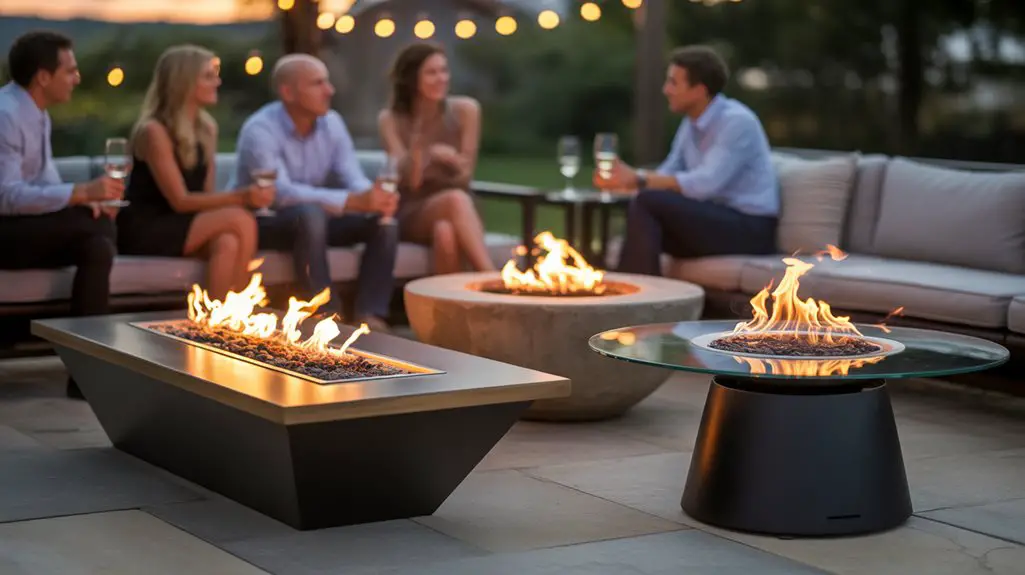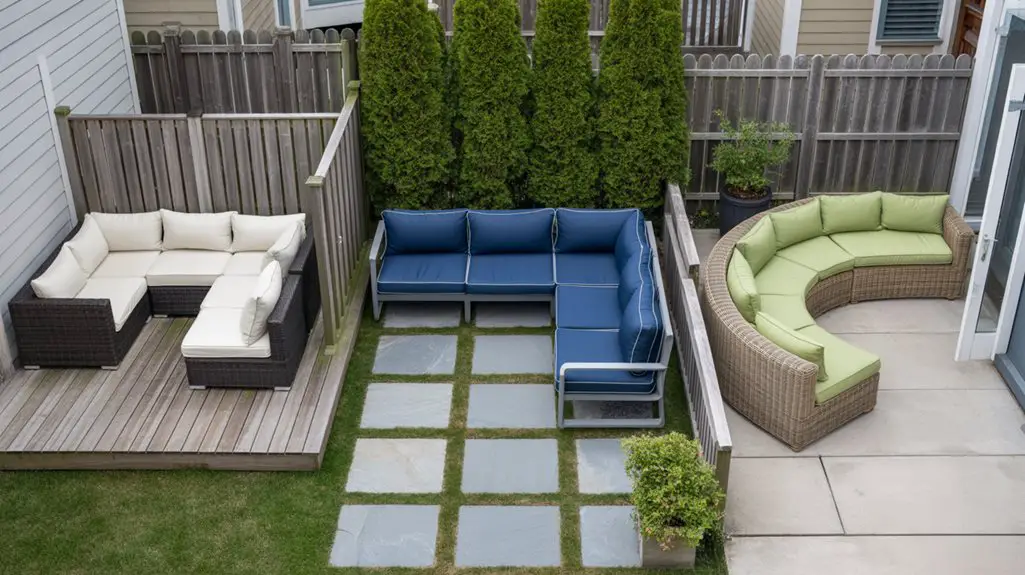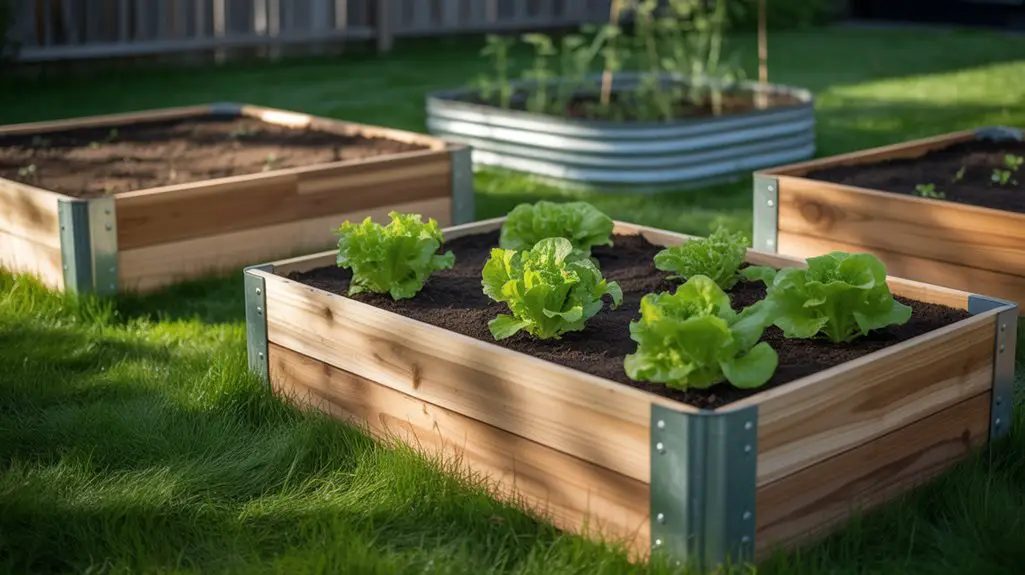You’ve probably stared at your limited garden space and wondered how to grow more without expanding outward. Vertical gardening kits offer the perfect solution, allowing you to stack your way to a more productive harvest. But with countless options flooding the market, choosing the right system can feel overwhelming. The three standout kits we’ve tested will transform how you think about maximizing every square inch of your growing area.
Amazing Creation Stackable 5-Tier Vertical Garden Planter
The Amazing Creation Stackable 5-Tier Vertical Garden Planter delivers an ideal solution if you’re working with limited space but want to grow 15 plants simultaneously. This terracotta-colored planter measures 12.5″ x 12.5″ x 24″ and weighs just one pound, making it perfect for indoor or outdoor use. You’ll appreciate its weather-resistant polypropylene construction that won’t fade or crack over time.
The design accommodates 5-inch plants and includes soil separators to prevent root binding. You can easily grow herbs, lettuce, succulents, and small vegetables. Assembly couldn’t be simpler—just stack the pots. With 4.3 out of 5 stars from over 1,500 reviews, customers praise its sturdy construction and quick growth results.
Best For: Beginner gardeners with limited space who want to grow herbs, lettuce, succulents, and small vegetables both indoors and outdoors.
Pros:
- Lightweight at just 1 pound yet durable with weather-resistant polypropylene construction that won’t fade or crack
- Space-efficient vertical design allows growing 15 plants in a compact 12.5″ x 12.5″ footprint
- Simple assembly process and includes soil separators to prevent root binding for healthier plant growth
Cons:
- Drainage issues can cause soil pooling and potential problems with mold or pests
- Limited space constraints make it unsuitable for larger plants beyond 5-inch varieties
- May require additional center support for stability when stacking multiple units or in windy conditions
VIVOSUN 5 Tier Vertical Gardening Stackable Planter
Compact living spaces and urban gardening enthusiasts will find their perfect match in the VIVOSUN 5 Tier Vertical Gardening Stackable Planter. You’ll appreciate its thick PP construction that resists cracking and provides long-lasting durability. The flexible design lets you stack 2-4 tiers or hang with chains, adapting to your space constraints.
You can grow strawberries, herbs, flowers, and vegetables efficiently using minimal floor space. The integrated water filtration system saves moisture while preventing surface staining with its included bottom dish. Whether you’re growing fresh produce in your kitchen or creating a balcony garden, this planter maximizes your growing potential in tight quarters.
Best For: Urban gardeners and apartment dwellers who want to maximize growing space for herbs, vegetables, and flowers in small indoor or outdoor areas.
Pros:
- Space-efficient vertical design allows multiple planting tiers in minimal floor space
- Durable thick PP construction resists cracking and provides long-term reusability
- Integrated water filtration system efficiently manages moisture while protecting surfaces
Cons:
- Limited to 2-4 tiers which may restrict growing capacity for larger gardens
- Requires careful weight distribution when fully loaded with soil and plants
- May need frequent watering monitoring due to vertical drainage system
SUNYRISY 5 Tier Vertical Wooden Raised Garden Bed
SUNYRISY’s 5-tier vertical wooden raised garden bed stands out as an excellent choice for gardeners who want maximum growing space without sacrificing their yard’s footprint. This 67-inch tall cedar planter lets you grow herbs, vegetables, flowers, and fruits in separate tiers, preventing overcrowding while maximizing yields.
You’ll appreciate the natural cedar construction that’s rot-resistant and built to last outdoors. The 31.5″ x 18″ footprint fits perfectly on patios, balconies, or small yards. Each tier includes leak-proof soil mats to prevent mess.
Assembly’s straightforward with included instructions, gloves, and screwdriver. You can even use it indoors as storage when not gardening. SUNYRISY backs their product with lifelong customer support.
Best For: Gardeners with limited space who want to maximize their growing capacity for herbs, vegetables, flowers, and fruits while maintaining organization and preventing plant overcrowding.
Pros:
- High-quality natural cedar wood construction that’s rot-resistant and durable for long-term outdoor use
- Space-efficient 5-tier design maximizes growing area in a compact 31.5″ x 18″ footprint
- Includes helpful accessories like leak-proof soil mats, assembly tools, and lifelong customer support
Cons:
- At 67 inches tall, may be difficult for shorter gardeners to reach the top tiers comfortably
- Cedar wood construction likely makes this a more expensive option compared to plastic alternatives
- Requires assembly which may be time-consuming or challenging for some users
Factors to Consider When Choosing 3 Vertical Garden Kits
When you’re selecting vertical garden kits, you’ll need to evaluate several critical factors that’ll determine your gardening success. The material and durability directly impact how long your investment lasts, while space dimensions and plant capacity options must align with your available area and growing goals. Don’t overlook drainage water systems and assembly requirements, as these affect both plant health and your ongoing maintenance efforts.
Material and Durability
Since vertical garden kits face constant exposure to outdoor elements, the materials they’re constructed from directly determine how long your investment will last. You’ll want to prioritize weather-resistant polypropylene plastic or natural cedar wood that resists rot and cracking over time. Thick PP construction provides superior durability compared to thin, flimsy alternatives that’ll deteriorate quickly.
While lightweight materials offer convenient portability, they compromise stability when you’re building taller vertical structures. You’ll need heavier, sturdier constructions or reinforced support features to prevent dangerous tipping as your garden grows upward.
Don’t overlook drainage solutions – leak-proof designs with proper water management protect both your plants’ health and the planter’s structural integrity. Poor drainage causes soil pooling that accelerates material degradation and undermines your entire system.
Space and Dimensions
Before you purchase any vertical garden kit, you’ll need to carefully measure your available space and match it against the planter’s dimensions. Whether you’re placing it on a balcony, in your kitchen, or on a patio, the kit’s footprint shouldn’t overcrowd your area while still providing adequate room for healthy plant growth.
Choose stackable designs that let you adjust tiers according to your vertical space, maximizing limited areas effectively. Consider the mature size of plants you want to grow—their height and spread requirements will determine the planter dimensions you need.
Evaluate the kit’s overall height for maintenance accessibility. You shouldn’t strain or bend excessively when watering, tending, or harvesting your plants.
Drainage Water Systems
After determining your kit’s spatial requirements, you’ll need to examine how water moves through your vertical garden system. Effective drainage prevents water pooling that causes root rot and mold growth, making it vital for plant health.
Look for kits with trickle-down water systems that distribute moisture evenly across all tiers. These systems guarantee plants at different levels receive adequate hydration without oversaturation. Drainage holes are non-negotiable features that allow excess water to escape, promoting healthy root development and preventing waterlogged soil.
Consider kits that include bottom dishes or trays to catch runoff water. These accessories prevent surface staining and make indoor gardening cleaner and more convenient. Well-designed drainage systems maintain proper moisture levels throughout your vertical setup, compensating for varying water retention between different tiers.
Plant Capacity Options
Three key factors determine the ideal plant capacity for your vertical garden kit: available space, plant types, and growth expectations. You’ll find kits ranging from compact 5-plant designs to expansive models supporting over 15 plants across multiple tiers.
Consider what you’re growing carefully. Small herbs and flowers thrive in compact kits, while larger vegetables need more space and fewer plants per tier. Multi-tier designs with 3 to 5 levels maximize your vertical space and accommodate diverse plant varieties.
Look for kits with soil separators—they optimize plant health and effectively increase your growing capacity. Don’t forget to assess the kit’s overall dimensions. You need adequate plant capacity, but it must fit your available gardening space perfectly.
Assembly and Maintenance
When evaluating vertical garden kits, you’ll want to prioritize models with simple assembly processes and low-maintenance designs. Look for kits featuring straightforward stacking mechanisms rather than complex installation requirements. Clear assembly instructions and included tools will greatly reduce setup frustration and save you time.
Consider kits with additional features like soil separators or water filtration systems, which help maintain plant health while reducing your care efforts. Lightweight materials offer practical advantages, making it easier to relocate your planter for ideal sunlight or seasonal adjustments.
While maintenance is generally minimal, you’ll need to monitor watering and drainage regularly to prevent mold and pest issues. Choose systems that make these routine checks convenient and accessible.
Frequently Asked Questions
How Much Water Do Vertical Garden Kits Typically Require per Week?
You’ll typically need 1-3 gallons weekly for most vertical garden kits, depending on plant types, climate, and system size. Check soil moisture daily and adjust watering frequency based on your specific growing conditions.
Can Vertical Garden Kits Be Used Indoors During Winter Months?
You can definitely use vertical garden kits indoors during winter. They’re perfect for maintaining fresh herbs and vegetables year-round. Just guarantee adequate lighting with grow lights and proper ventilation for healthy plant growth.
What Vegetables Grow Best in Vertical Garden Kit Systems?
You’ll find leafy greens like lettuce, spinach, and kale thrive in vertical systems. Cherry tomatoes, herbs such as basil and parsley, and compact peppers also grow exceptionally well in these space-saving garden kits.
How Long Do Vertical Garden Kits Typically Last Before Replacement?
You’ll typically replace vertical garden kits every 3-5 years, depending on materials and maintenance. Plastic systems last shorter while metal or cedar versions endure longer. Proper care extends lifespan considerably beyond manufacturer warranties.
Do Vertical Garden Kits Require Special Soil or Regular Potting Mix?
You’ll need high-quality potting mix rather than regular garden soil. Choose lightweight, well-draining blends designed for containers. Avoid heavy soils that retain too much water and can cause structural problems in vertical systems.
Conclusion
You’ll transform your limited space into a thriving garden with any of these three exceptional vertical planters. Whether you’re starting small with the Amazing Creation’s beginner-friendly design, need VIVOSUN’s urban-focused filtration system, or want SUNYRISY’s maximum growing capacity, you’ve got options that’ll suit your gardening goals. Don’t let space constraints hold you back—choose the vertical solution that matches your needs and start growing upward today.







